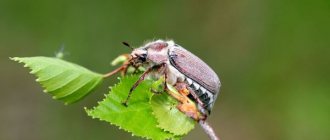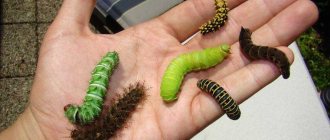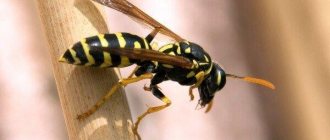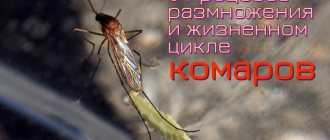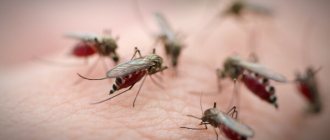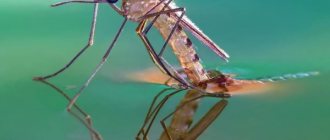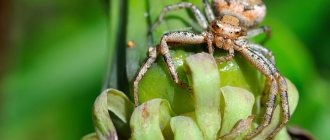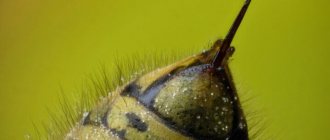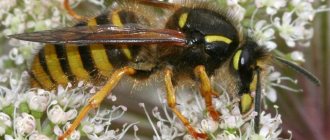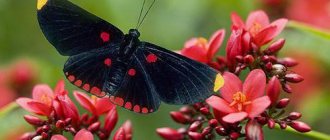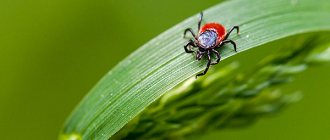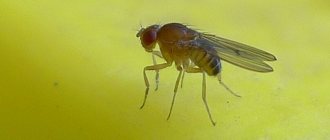What does a cockchafer look like?
An adult insect reaches a length of 3.5 centimeters. The body of the cockchafer has an elongated oval shape and is black or brown in color. The beetle has 2 double wings, which are attached to the chest. There are 3 pairs of legs. The body of the cockchafer consists of a head, chest and abdomen, which are covered with protective chitin. The abdomen consists of 8 segments, the chest - of 3 segments.
The elytra protect the hind wings. The head is small. May beetles in down jackets - this is exactly the picture that appears if you look closely at the insect. Its entire body is covered with numerous hairs.
The May Khrushchev has excellent eyesight thanks to its bulging eyes. Each eye consists of thousands of simple ocelli. There is one pair of antennae that perform an olfactory function. The cockchafer has a gnawing type of mouth.
Means of struggle
Chemical and biological drugs
Antikhrushch
The insectoacaricide affects the nervous system of the pest, paralyzes it and the larvae quickly die. Indirectly, the drug reduces the risk of viral and fungal diseases.
Before planting potatoes, the soil is sprayed with a working solution at the rate of 10 ml of product per 5–10 liters of water. This volume is designed to process 1 hundred square meters.
To soak the roots of vegetable seedlings and fruit tree seedlings, dilute 10 ml in 3 liters of water.
The soil around strawberries, berry bushes and fruit trees is watered with a solution of 10 ml of the drug and 5 liters of water.
Vallar
According to reviews from summer residents, this new drug is one of the most reliable in the fight against May beetle larvae. 5–6 granules are scattered around the plants in the root zone and embedded in the soil to a depth of 5–10 cm.
Before planting, a mixture of an insecticide solution with soil is prepared to treat the roots of seedlings of fruit and ornamental plants. 3 tsp of the product is added to 200 ml of water and stirred. Pour soil into the container, add the solution and pour in more water, bringing the volume of the “chatterbox” to 1 liter. The roots are dipped into this mass before planting.
Zemlin
Once in the pest's body, the insecticide blocks basic life functions. The larvae cannot move, absorb food and soon die. Granules of the drug are applied to the ground when planting plants in holes or during the growing season at the rate of 30 g per 20 square meters. m.
Bazudin
Contact insecticide with intestinal action based on diazinon. The consumption rate of the drug is 30 g of granules per 20 square meters. m. landing. They are first mixed with dry sand or sawdust, the soil is loosened and the mixture is scattered evenly.
Initiative
An effective contact action drug. Shows protective properties during the first day after use. 30 g of microgranules are poured into a 1 liter container of dry sand, mixed and evenly scattered around the root zone.
Nemabact
A unique biological product for pest larvae based on beneficial nematodes. The contents of the package (foam rubber crumbs) are poured into a colander, which is placed on a bucket and washed with water (10 l), periodically squeezing out the crumbs. The resulting solution is stirred and used to water the soil.
Traditional methods
- Plants are watered at the root with a strong infusion of onion peels. Half the bucket is filled with onion peels, hot water is added to the brim and left for a day. The infusion is filtered, but not diluted before use.
- Ammonia will repel larvae from the area. Dissolve 20–30 ml in 10 liters of water and water the soil. This treatment is also good as a preventive measure for strawberry bushes.
- To prevent the pest, potato seedlings and vegetable seedlings are watered with a solution of potassium permanganate (3–5 g per 10 liters of water). The soil has been watered with the indicated solutions since May, when the pest has already risen to the root layer.
- Mustard clears the area of larvae; they do not like the smell of this plant. Starting in spring, the row spacing and soil around the trees are sown with mustard or other cruciferous crops. When the green mass grows, it is embedded in the soil.
- Planting leguminous plants has a similar effect on the pest: lupine, beans, peas, beans. The soil under trees and shrubs can be covered with white clover. On the roots of this plant, as well as on legumes, bacteria are formed that participate in the accumulation of nitrogen in the soil. The cockchafer larvae cannot tolerate this.
- In May, adults are collected by hand. In the morning, insects are inactive, so when they are spotted, the branches of trees and shrubs are carefully shaken off, the beetles are collected and destroyed.
- Traps are built to catch insects. Plastic bottles with cut off necks are hung on trees. Sweet fermented liquid (compote, diluted jam, kvass, beer) is poured into containers.
- The cockchafer is attracted to any light source at night. Therefore, the trap is installed next to a switched-on flashlight or light bulb. The bait can be a wide container of water: a basin, a bucket, a bowl.
- For another option, the inner walls of an empty container are coated with any viscous and sticky substance. The insects that fly to the light will fall into a trap; in the morning all that remains is to collect and destroy them.
Bronzovka, or green May beetle
The cockchafer is often confused with the bronze beetle, which, unlike the hero of our article, is green. The bronze beetle is not a May beetle, although these insects belong to the same family, that is, they are close relatives.
The life cycle of a green insect from egg to adult is 2-3 years. The female bronze bird lays eggs very often in anthills. Bronzewort does not cause any particular harm, because it appears after the flowering of cultivated plants. It feeds on plant flowers and is listed in the Red Book.
Reasons for the appearance of the pest on the site
May beetles prefer sandy soils ; they are less common in heavy clay areas. It is more convenient for females to lay eggs in uncompacted soil. They love well-groomed and cultivated gardens and vegetable gardens ; here they have favorable conditions - nutritious soil, many plants, compost and humus heaps .
The life activity of the larvae is affected by temperature and humidity. High humidity is detrimental to them, and when the temperature rises above 25°C, they sink to great depths. During spring cold snaps and recurrent frosts, the cockchafers freeze and may die.
Pest numbers are reduced by exposure to fungi, bacteria and parasitic nematodes.
Life cycle of the cockchafer
The life cycle of the cockchafer is 3-5 years. Life cycle phases:
- egg stage (30-40 days);
- pupal stage (30-60 days);
- larval stage (3 years);
- stage of an adult insect, or imago (1 year).
The eggs are found in the ground at a depth of 30 cm, they are white in color and have a diameter of 2.5 mm. After 30-40 days the larvae hatch. They have a thick white body, 3 pairs of legs, and a head with well-developed jaws.
The cockchafer larva develops for 3 years and overwinters underground. All this time she feeds on plant roots. At the beginning of August, the larva burrows deeper into the ground and turns into a pupa. An adult cockchafer insect develops from the pupa.
Signs of plant infection
Adults feed mainly on leaves. They eat or make holes in leaf blades, damage buds, ovaries and flowers. Because of this, the process of photosynthesis in plants is disrupted, they weaken and wither.
The larvae cause more harm; they are voracious and damage plant roots; 3–5 of them can completely destroy the root system of a young tree. Even minor damage makes the plant vulnerable to pathogens. Young plants wither and are easily removed from the ground, and adult specimens, having a reserve of vitality, do not die, but slow down their development. Yields of vegetables and fruits are reduced, side shoots on trees do not ripen well.
Adult insects and larvae are easy to detect on above-ground parts and in the soil and make sure that they are the cause of crop damage.
Fighting the cockchafer
With the onset of warm weather, May beetles actively begin to eat leaves and shoots of trees. More terrible than the larvae of the cockchafer - they eat the entire root system of the plant in the ground, and it dies.
Preparations to combat the cockchafer and its larvae:
- Zemlin;
- Nemabact;
- Aktara;
- Antikhrushch.
Traditional methods of struggle:
- shaking off trees;
- use of birds (chickens, starlings);
- You can hang a white canvas and illuminate it with bright light. May beetles will crawl onto the canvas;
- plant white clover or lupine where you want to kill the larvae.
What crops does the pest affect?
Chafer beetles are polyphagous and damage many crops. Adult insects gnaw leaves and ovaries of poplar, oak, maple, birch, aspen, alder, walnut, linden, willow, elderberry, acacia, elm, honeysuckle, alder, rowan, and rosehip.
The insect can be seen on fruit trees and shrubs: apple, plum, cherry, grapes, sea buckthorn, black currant, gooseberry. Beetles love the needles of pine, spruce, larch, and cedar. Only the ash tree is lucky; the pest avoids it.
The larvae feed on the roots of these trees, roots and root crops of vegetable crops: potatoes, onions, beets, corn, sunflowers. The larvae cause great damage to strawberry plantations.
How to catch chub using a cockchafer?
But for fishermen, May beetles are a real value, because they can be used to catch some species of fish. Catching chub with a cockchafer occurs as follows. We cast the fishing rod, lower the line and wait for the bite. The bait should not move...
You will quickly feel the bite and hook. But don’t rush to pull out the chub, let him walk with the bait. Chub is a good catch using a cockchafer wobbler. The cockchafer wobbler is an artificial but effective bait.
Types and photos of the pest
Various types of May beetle inhabit almost all of Europe, Asia Minor, the Caucasus, most of the Siberian taiga and Central Asia, Syria, northern Iran, India, Japan, China, also Tibet, Indochina and the Philippine Islands. The main types of the May beetle are the western May beetle, the eastern May beetle and the Caucasian marbled beetle.
The Western May beetle is a beetle 23-32 mm long with a strong, wide and strongly protruding body. The lower part of the body, head and pronotum are black. The color of the elytra, legs, antennae, palps and posterior part of the abdomen is light brown, red-brown or almost black-brown. This species is characterized by significant color variability and may have a color that is very different from the typical one. They live in most of Europe, in the east in the European part of the CIS.
Western May Khrushchev
The pronotum is dark in color with short gray-yellow hairs. The elytra are curved, elongated oval, with 5 thin ribs, covered with frequent short hairs of white or gray color and scattered longest bristling hairs. The base and sides are covered with sparse long bristling yellowish-gray hairs, the ribs have distinct, rather small points. Chest covered with long, dense white-gray hairs. The posterior section of the abdomen in the male is elongated at the apex into a thin process; in the female it is slightly shorter.
The eastern May beetle or eastern May beetle is similar to the western May beetle, but has some differences from it in color and a number of other characteristics. The body is 20-29 mm long. Females are larger than males. The body is large, elongated-oval, curved forward. Coloring is variable.
The extreme segment of the maxillary palps is elongated and slightly curved. The head is small, retracted into the pronotum and covered with fairly dense punctures, with frequent, long, bristling light yellowish-gray hair. Eyes protruding forward, medium size. The posterior part of the abdomen is very steep, turning into a process at the apex. The posterior section of the abdomen is quite vertical, at the apex it is narrowed into a process, which at the apex is again widened and rounded; in the male it is not very long; in the female it has the same width along the entire length, and sometimes is completely absent.
Eastern cockchafer
There are two subspecies of Oriental Khrushchev:
- Melolontha hippocastani romana - the upper body, together with the pernotum, is covered with frequent white hair-like scales that turn into hairs.
- Melolontha hippocastani mongolica - stands out for its strongest, wide body, short and wide posterior abdomen. Length 19-27 mm.
Caucasian marbled beetle - the body of an adult beetle 30-37.8 mm long; width – 14.2-18.5 mm. Black or brown-black color. There is a yellow pattern on the head and pronotum, and a white scaly pattern on the scutellum and elytra. The color of the antennal club is black-brown.
Phases of development
Weevil on strawberries Weevil on strawberries
The beetles become active in June or July, and their flight lasts up to 1.5 months.
The behavior of the pest depends on its habitat. Thus, those living in the forest eat tree leaves or pine needles during daylight hours. Here they choose not only trees, but also thickets of tall grass and bushes. Adults living in the steppe prefer to hide in the soil during the day. Their activity becomes more active only at dusk, but continues throughout the night. As a rule, the males take flight, and the females wait for them on the plants.
Mating of beetles begins a week after additional feeding. Females lay eggs in the soil, each capable of producing from 20 to 30 eggs. The period of embryo development depends on temperature and environmental conditions, and in different regions it lasts different times: from 4 to 6 weeks.
The larva lives in the upper layers of the soil and eats plant roots. It goes into the deep layers of the soil to spend the winter. The larva overwinters once or twice.
The pupation period begins in early May, and at this time the larva rises closer to the surface, to a depth of approximately 15 cm. Pupation takes from 1 to 2 months, so some adults may appear in July.
Getting rid of Khrushchev
Physical removal
- Shake them off the trees in the morning, when the beetles are frozen, and destroy them by mechanical force.
- Regularly dig up tree trunk circles. All larvae must be selected manually.
- Leaves under trees should be burned.
Light traps
At night, the lantern is lit. A container of water mixed with a small amount of kerosene is placed under it. Insects attracted by the light will hit the lamp body and fall down. As an option, you can place a basin coated with grease or spread newspapers covered with long-drying glue. During the night, a considerable number of insects will gather in such traps, which will be burned or destroyed in some other way.
Biological method
Set up a house on your site for starlings or rooks. These birds love to feast on large beetles, which are a source of huge amounts of nutrients. Where these birds live, there is no place for Khrushchev. It is known that a pair of starlings, during the period of raising chicks, consumes and feeds to their offspring up to 8,000 adults and their larvae.
Chemicals
Against soil-dwelling pests, such as cockchafers, the modern market offers a whole range of chemicals of the insecticidal group:
- "Fix it";
- "Zemlin";
- "Aktara";
- "Bazudin";
Also, the Ukrainian-made Antikhrushch pesticide enjoys positive feedback from consumers.
Particular attention to larvae
Khrushchev larva
Having taken a number of measures against the cockchafer, you should not relax. Re-infection of the site is more than important. Therefore, it is necessary to carry out preventive measures periodically. Eg:
- Water the strawberry/strawberry beds with an aqueous solution of ammonia, which is prepared at the rate of 1 tbsp. l. for 10 liters of water;
- during autumn digging, potentially dangerous areas need to be filled with a composition such as “Whiteness” or simply add a little dry powdered bleach to the soil;
- between the rows of plants, make grooves up to 40 cm deep into which pour Carbofox solution;
- The soil of the beds must be well mulched.
